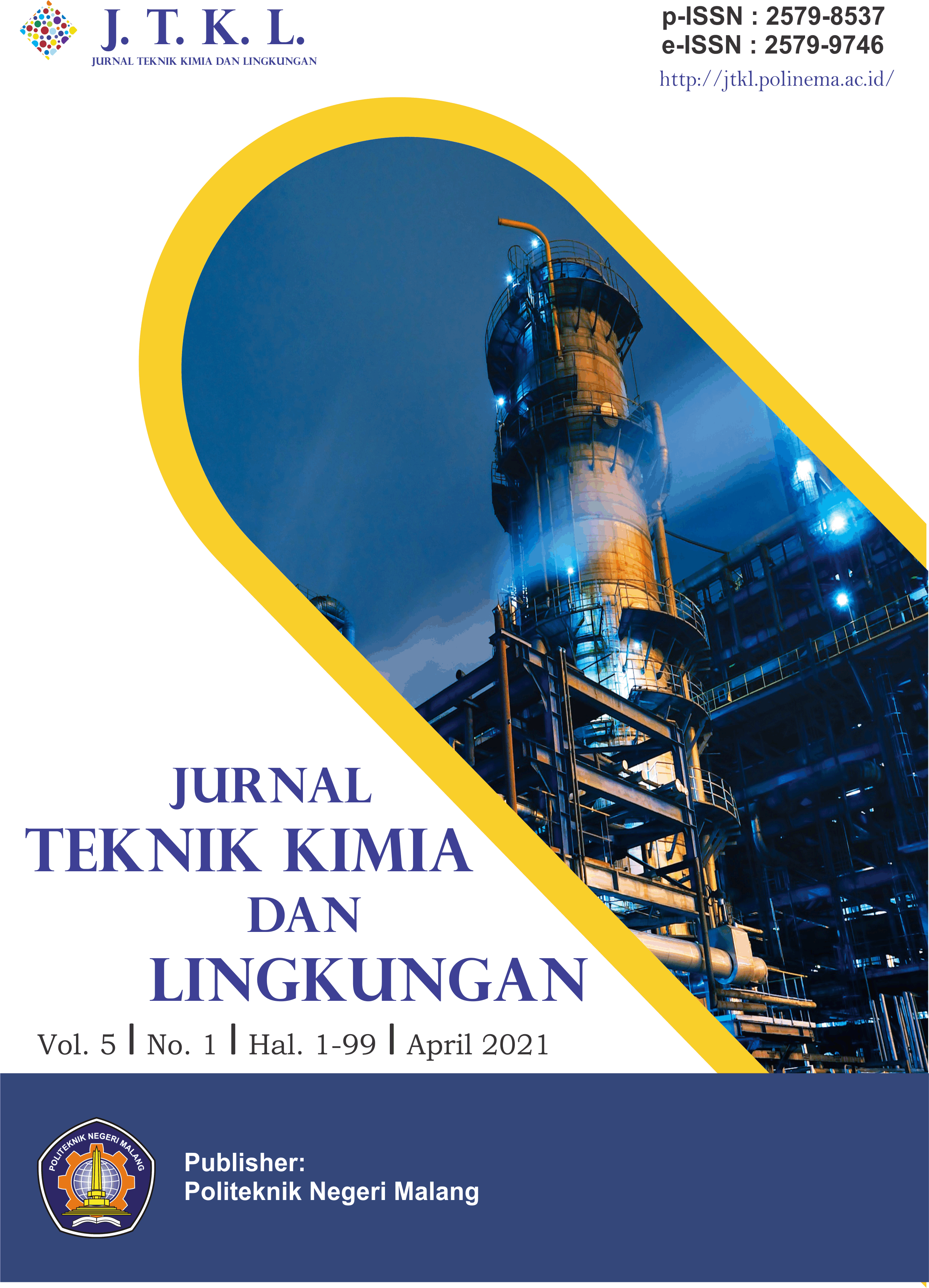Dinamika dan Karakter Produk Hasil Dekarboksilasi Sabun Hidroksi Pelargonat
DOI:
https://doi.org/10.33795/jtkl.v5i1.210Keywords:
Decarboxylation, magnesium hydroxy pelargonate, soap.Abstract
The development of biofuel have a lot of advantages for national growth, such as, imports reduction of fuel and increasing national energy security and sustainability. Therefore, biofuel production technology for substitution of fuel oil especially gasoline, is very important. One of technology method to produce biogasoline is decarboxylation of pelargonic hydroxy metal soap. Magnesium hydroxy pelargonate [Mg(OH)(OOCC8H17)] can be decarboxylated to produce n-octane [C8H18] and magnesium carbonate [MgCO3] which at temperatures close to 500oC decompose into MgO and CO2. The objectives of this research is to investigate comprehensively the dynamics and character liquid products from decarboxylation of pelargonic hydroxy soap [Mg(OH)OOCC8H17] reaction at temperature range of 250-350oC.
References
Suharyati, S. H. Pambudi, J. L. Wibowo, N. I. Pratiwi, Outlook Energi Indonesia 2019, Jakarta: Sekretariat Jenderal Dewan Energi Nasional, 2019.
M. S. Boedoyo, L. O. M. A. Wahid, I. Fitriana, N. Niode, R. E. Puspita, E. Siregar, A. K. Paminto, E. Suarna, P. T. Wijaya, A. Kismanto, A. A. Raksodewanto, Yudiartono, A. Sugiyono, Suryani, Anindhita, I. Fitriana, N. Gustriani, Outlook Energi Indonesia 2014, Jakarta: Badan Pengkajian dan Penerapan Teknologi, 2014.
Produk Olahan Minyak & Gas, http://ashadisasongko.staff.ipb.ac.id/tag/knocking/, diakses 23 Februari 2021.
C.-C. Chang, S.-W Wan, China’s Motor Fuels from Tung Oil, Industrial and Engineeering Chemistry, vol. 39, no. 12, hal. 1543-1548, 1947.
Setiadi, A. Suranto, Reaksi Dekarboksilasi Minyak Jarak Pagar Untuk Pembuatan Hidrokarbon Setara Fraksi Diesel dengan Penambahan Ca(OH)2, Seminar Nasional Teknik Kimia Indonesia (SNTKI), Bandung, 19-20 Oktober 2009.
H. Tani, T. Hasegawa, M. Shimouchi, K. Asami, K. Fujimoto, Selective Catalytic Decarboxy-Cracking of Triglyceride to Middle-Distillate Hydrocarbon, Catalysis Today, vol. 164, No. 1, hal. 410-414, 2011.
D. L. Perry, Handbook of Inorganic Compounds, Second Edition, India: CRC Pres, 2011.
E. Puspawiningtiyas, M. Pratiwi, G. F. Neonufa, R. Purwadi, A. N. Isyami, L. Elizabeth, T. H. Soerawidjaja, Subagjo, T. Prakoso, Effect of Metal Type on Basic Soap Pyrolysis Produce Bio-gasoline, IOP Conf. Series: Materials Science and Engineering, vol. 823, no. 012027, hal. 1-9, 2020.
Spesifikasi Premium, https://www.pertamina.com/industrialfuel/media/20705/premium.pdf, diakses 23 Februari 2021.
Chemical Book 540-08-9, 9 Heptadecanone, https://www.chemicalbook.com/CASEN_540-08-9.htm, diakses 9 September 2016.
Chemical Book 693-54-9, 9 2-Decanone, https://www.chemicalbook.com/ChemicalProductProperty_EN_CB8274144.htm, diakses 9 September 2016.
Chemical Book 592-76-7, 9 1-Heptene, https://www.chemicalbook.com/ChemicalProductProperty_EN_CB7378609.htm, diakses 9 September 2016.
G. F. Neonufa, K. Amri, T. Prakoso, T. H. Soerawidjaja, Pengaruh Kombinasi Logam pada Reaksi Dekarboksilasi Sabun Basa terhadap Produk Biohidrokarbon Cairnya, Prosiding Seminar Nasional Teknik Kimia UNPAR, Bandung, 4 Mei 2017.
Downloads
Published
Issue
Section
License
Copyright (c) 2023 Ella Melyna, Tirto Prakoso, Tatang Hernas Soerawidjaja

This work is licensed under a Creative Commons Attribution-NonCommercial 4.0 International License.







